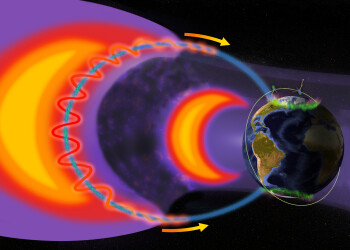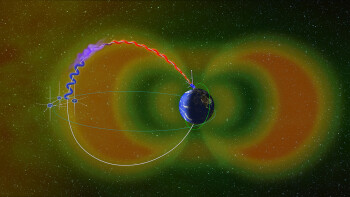Ph.D. - Space Physics
University of California, Los Angeles - 2014

Xiaojia Zhang
Eugene McDermott Distinguished Professor
Associate Professor – Physics – Space Sciences
Dr. Zhang joined the Department of Physics at University of Texas at Dallas as an associate professor in Fall 2022. Prior to that, she was an associate researcher in the Department of Earth, Planetary, and Space Sciences at UCLA, where she received her M.S. and Ph.D.
+1 (972) 883-2873
WTC2706
Group Page
William B. Hanson Center for Space Sciences
Google Scholar Page
ORCID
Professional Preparation
M.S. - Space Physics
University of California, Los Angeles - 2010
University of California, Los Angeles - 2010
B.S. - Space Physics
Peking University - 2008
Peking University - 2008
Research Areas
- Wave-particle interactions in Earth’s and Jovian magnetospheres
- Aurora and particle precipitation
- Excitation and propagation of plasma waves
- Plasma kinetics in the planetary magnetospheres
- Incorporating plasma waves into space weather modeling
- Instrument and CubeSat development
Publications
Evolution of electron distribution driven by nonlinear resonances with intense field-aligned chorus waves - Journal Article
Evolution of electron distribution driven by nonlinear 676 resonances with intense field-aligned chorus waves - Journal Article
Energetic Electron Precipitation Driven by the Combined Effect of ULF, EMIC, and Whistler Waves 2022 - Journal Article
Characteristics of Electron Microburst Precipitation Based on High-Resolution ELFIN Measurements 2022 - Journal Article
Electron magnetosonic waves and sub-ion magnetic holes in the magnetotail plasma 2022 - Journal Article
Electron Resonant Interaction With Whistler Waves Around Foreshock Transients and the Bow Shock Behind the Terminator 2022 - Journal Article
Ducted chorus waves cause sub-relativistic and relativistic electron microbursts 2022 - Journal Article
Superfast precipitation of energetic electrons in the radiation belts of the Earth 2022 - Journal Article
Awards
Young Scientist Award - URSI GASS [2021]
Appointments
Associate Professor
University of Texas at Dallas [2022–Present]
University of Texas at Dallas [2022–Present]
Associate Researcher
University of California, Los Angeles [2020–2024]
University of California, Los Angeles [2020–2024]
Assistant Researcher
University of California, Los Angeles [2014–2020]
University of California, Los Angeles [2014–2020]
Graduate Student Researcher
University of California, Los Angeles [2008–2014]
University of California, Los Angeles [2008–2014]
Undergraduate Research Assistant
Peking University [2006–2008]
Peking University [2006–2008]
News Articles
NASA-funded CubeSat Discovers Source of Super-fast Electron Rain
 Using a NASA-funded CubeSat, scientists have uncovered a new source of super-fast, energetic electrons raining down on our planet, which can have implications for space infrastructure and atmospheric modeling.
Using a NASA-funded CubeSat, scientists have uncovered a new source of super-fast, energetic electrons raining down on our planet, which can have implications for space infrastructure and atmospheric modeling.The near-Earth space environment is highly dynamic and filled with charged particles orbiting in giant rings around the planet called Van Allen radiation belts. Similar to a coiled slinky bouncing back and forth between two hands, electrons in the radiation belts travel in spirals between Earth’s North and South magnetic poles. Under certain conditions, electromagnetic vibrations called whistler waves can occur in the radiation belts, energizing and speeding up the electrons so much that they can be lost into the atmosphere, creating the electron rain.
Combining THEMIS observations of whistler waves, ELFIN’s electron data and sophisticated computer modeling, the team saw how the whistler waves caused a rapid torrent of electrons to flow into the atmosphere, far beyond the amount expected from previous theories. Current space weather models do not account for this extra electron flow, which not only contributes to dazzling auroras, but can damage low-orbiting satellites and affect atmospheric chemistry.
UCLA researchers discover source of super-fast ‘electron rain’
 UCLA scientists have discovered a new source of super-fast, energetic electrons raining down on Earth, a phenomenon that contributes to the colorful aurora borealis but also poses hazards to satellites, spacecraft and astronauts. The researchers observed unexpected, rapid “electron precipitation” from low-Earth orbit using the ELFIN mission, a pair of tiny satellites built and operated on the UCLA campus by undergraduate and graduate students guided by a small team of staff mentors.
UCLA scientists have discovered a new source of super-fast, energetic electrons raining down on Earth, a phenomenon that contributes to the colorful aurora borealis but also poses hazards to satellites, spacecraft and astronauts. The researchers observed unexpected, rapid “electron precipitation” from low-Earth orbit using the ELFIN mission, a pair of tiny satellites built and operated on the UCLA campus by undergraduate and graduate students guided by a small team of staff mentors.
Interview by MIT Technology Review China (in Chinese)
This interview introduces the background, implications, and process of our study on super-fast energetic electron rain from Earth's radiation belts. It also outlooks the future of our research from the author's personal perspective.Activities
Professional Activities
- Session chair for the 2019, 2020, 2021 Fall AGU meeting
- Session convener for the 2022 AOGS meeting
- Judge for Outstanding Student Poster and PICO (OSPP) Award in the EGU meeting (2019)
- Judge for Outstanding Student Paper Awards in the Fall AGU meeting (2015− present)
- Panelist for National Aeronautics and Space Administration (NASA) proposals (2022)
- External reviewer for National Aeronautics and Space Administration (NASA) proposals (2017, 2020)
- Guest editor on the THEMIS/ARTEMIS special issue at JGR (2022)
- Topic editor on “Quasilinear and Nonlinear Wave-Particle Interactions in Magnetospheric Plasmas” at Frontiers (2022)
- Referee (2014 − present) for Journal of Geophysical Research – Space Physics, Geophysical Research Letters, Advances in Space Research, Annales Geophysicae, and Nature Communications
- Tohban (Scientist-in-Charge) of downlink quality assessment for the THEMIS mission (2 weeks per 6 months, 2011 − 2017)
- Tohban (Scientist-in-Charge) of downlink quality assessment for the ELFIN (CubeSat) mission (2 weeks per 3 months, 2020 − 2022)
- Science team member in the Juno mission (2015 − present)
- Science team member in the Van Allen Probes mission (2014 − 2019)
- Science team member in the THEMIS mission (2008 − present)